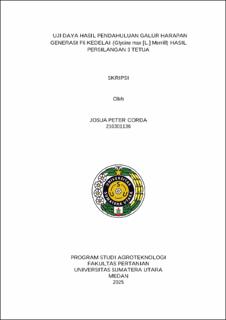Uji Daya Hasil Pendahuluan Galur Harapan Generasi F6 Kedelai (Glycine max [L.] Merrill) Hasil Persilangan 3 Tetua
Preliminary Yield Test of F6 Generation of Soybean [Glycine max (L.) Merrill] Result of Crossing 3 Parents
Abstract
Soybeans (Glycine max [L.] Merrill) are one of the plant-based protein commodities that experience an increase in demand every year. Plant breeding through the development of new superior varieties is a solution to meet the demand for soybeans. This study aims to evaluate several promising lines resulting from crosses to identify genotypes with potential for release as new varieties. The preliminary yield trial was conducted on a plot located at Jalan Pasar 1 No. 296, Medan City. The method used was a non-factorial Randomized Block Design (RBD) with three replications. The treatments used were 8 genotypes consisting of three promising lines: F5.13 8/4/361, F5.46 9/3/331, F5.419 7/1/71, and five national high-yielding varieties: Anjasmoro, Grobogan, Dega 1, Derap 1, and Devon 2. The parameters observed included flowering time, harvest time, plant height, number of primary branches, number of pods per plant, number of seeds per plant, weight of 100 seeds per plant, seed weight per plant, yield per genotype, and yield per hectare. The research results were tested using an F-test at the 5% level. Parameters that were significantly different were further tested using a BNT test at the 5% level. Based on the research results, all three lines exhibit uniformity and have their own advantages. Line F6.46 9/3/331 has the highest number of pods among all lines and parents, while line F6.419 7/1/71 has the best 100-seed weight among all genotypes. Line F6.13 8/4/361 has an early maturity period and a large 100-seed weight (large seed size). All three lines have better yield potential than the national elite varieties Anjasmoro, Grobogan, and Dega 1. Line F6.46 9/3/331 has a yield potential of 1.85 tons/ha, Line F6.13 8/4/361 has a yield potential of 1.8 tons/ha, and line F6.419 7/1/71 reaches 1.87 tons/ha, but it is not better than the Devon 2 and Derap 1 varieties, which reach 2 tons/ha. These lines have the potential to be developed and further tested as new superior varieties.
Collections
- Undergraduate Theses [3569]

